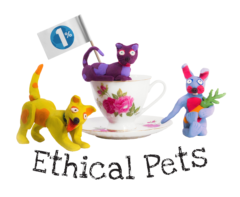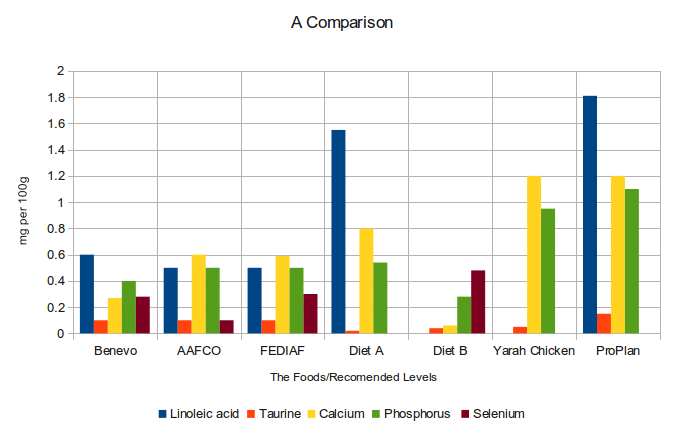 Is vegan cat food natural, safe or healthy?
Is vegan cat food natural, safe or healthy?
In 2003 Tina M Gray sent a sample of two American vegan cat food brands to a lab. She found that both were deficient in some of the specified/required levels of nutrients. She concluded that these specific foods “could not be recommended as a sole source of nutrition for cats.” [1] Andrew Knight argued that the results were caused by poor quality control during feed manufacture, but that cats can still be vegan safely [1b]. Three years later, Wakefield, Shofer and Michel took blood and plasma samples from several American vegan cats to look for likely deficiencies. They found most had normal results, a few had poorer than normal results but none were critically deficient [2].
These two studies represent the bulk of research into the effects of vegan cat food, therefore a) decisive answers are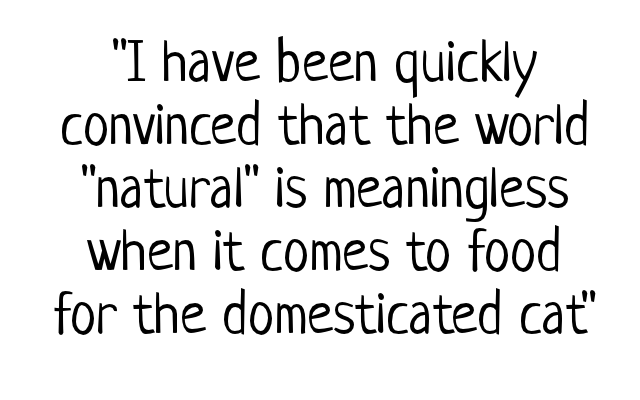 impossible and b) debate amongst scientists is polarized and based more on opinion than data. Because of this, the pop-science web chatter is often oversimplified, assumptive or inaccurate. This article will address some of the assumptions about both meat and vegan cat foods.
impossible and b) debate amongst scientists is polarized and based more on opinion than data. Because of this, the pop-science web chatter is often oversimplified, assumptive or inaccurate. This article will address some of the assumptions about both meat and vegan cat foods.
First of all, are the brands you sell “nutritionally complete?”
Yes
So what does that actually mean?
The term nutritionally complete generally means “does the food fulfil the criteria recommended by the appropriate authority.” Something to consider about this: some, possibly most, of the data used to set these recommendations will have been gathered in an unethical manner. I actually started looking into this by following up references from the Gray 2003 study, but quickly decided I couldn’t face the horror after the first thing I read was “Scott and Thompson (1969) found that the vitamin A concentration in the diet of the [mother cat] influenced the concentration of vitamin A in the liver and kidneys of the unsuckled newborn kitten.” [3]
Please see the tables below for an overview of recommendations and levels across various foods. Diet A and Diet B, refer to the nutritionally incomplete foods discussed in the Gray study; the results for the Benevo vegan food are from a lab analysis [4].
Thats a lot of variance, how do we know what’s best? For example, what do cats eat naturally?
Dr Andrew Knight, a vegan Veterinary Biologist, makes some interesting (and humorous) comment s in his 2008 article in LifeScapeMag about about which foods are commonly considered to be natural for cats. He asks if we have ever seen cats “swim 10-20 miles out into the ocean, hunting blue-fin tuna weighing up to half a ton, which they engage in underwater battles to the death” or feral cats in Africa “stalking and hunting large game, notably cows, sheep and pigs.” [5]. Put in this light, even the simple premise “cats eat meat” is not so simple after all; vegan cat food may seem unnatural, but then again, cats certainly wouldn’t naturally “garnish their meals with… species such as salmon, prawns and whitebait.”
s in his 2008 article in LifeScapeMag about about which foods are commonly considered to be natural for cats. He asks if we have ever seen cats “swim 10-20 miles out into the ocean, hunting blue-fin tuna weighing up to half a ton, which they engage in underwater battles to the death” or feral cats in Africa “stalking and hunting large game, notably cows, sheep and pigs.” [5]. Put in this light, even the simple premise “cats eat meat” is not so simple after all; vegan cat food may seem unnatural, but then again, cats certainly wouldn’t naturally “garnish their meals with… species such as salmon, prawns and whitebait.”
The Campaign for Real Pet Food suggests that “good quality natural pet foods only use identifiable, named meats, such as chicken, fish and lamb” and that they should be “free from artificial additives such as colours, preservatives and flavours.” [6] While this great campaign calls for honest labelling, education and the removal of chemicals (all important and worthy aspirations) I am not especially convinced that the cat products certified by them are are “real” or “natural” in any biological or behavioural sense: for example, they contain ingredients such as salmon, prawn, herring, chicken, egg, rice, oats, barley, lactose reduced milk and pork digest [7]. The very fact that they nee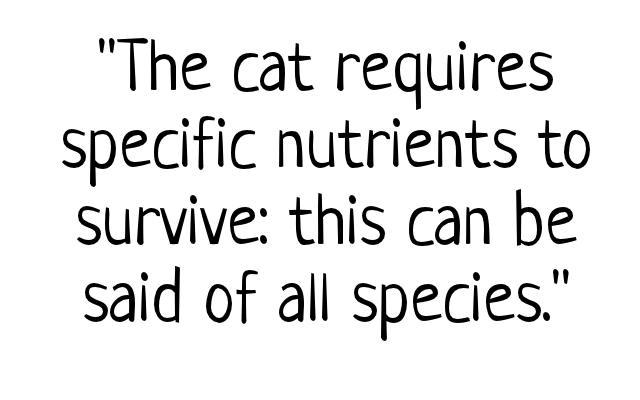 d to reduce the lactose in the milk, for example, suggests it is not a natural food for the cat.
d to reduce the lactose in the milk, for example, suggests it is not a natural food for the cat.
Then we have the Pork Digest: Dr Kight talks about “digest” in a particularly scathing manner, claiming that it is a disgusting result of industry greed and that the word is a “euphemism for a soup of partially dissolved intestines, livers, lungs and miscellaneous viscera of chickens (primarily) and other animals, produced using various enzymes and acids” [8] – the specific recipe being a “closely guarded trade secret.” It’s the thing that makes dry cat food smell that special way when you open the bag.
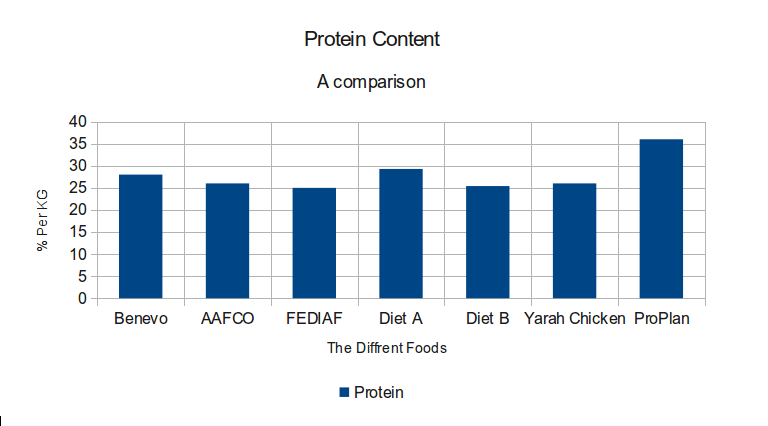
“Natural” isn’t just about the ingredients either, even the way we feed our cat is totally unnatural – constant access to dry food and identically sized portions of meat delivered at the same times every day. So, the idea that “commercial meat-based diets allow greater expression of natural behaviour” is also a fallacy. [8]
I have been quickly convinced that the world “natural” is close to meaningless when it comes to food for the domesticated cat; in fact, I will go as far as to say it would probably be cruel to try and feed them in a truly natural way and on what would truly be their natural diet.
But surely meat is still better than no meat?
Not always, and this is where the situation gets a little grim really: both Dr Knight and the Campaign for Real Pet Food (CRPF) would agree – there are often all sorts of nasties in pet foods. CRPF focus mostly on the ingredients disguised with phrases like “EC permitted additives” and “derivatives of vegetable origin” whereas Dr Night talks about contaminates too. Meat-based pet foods have been known include, most shockingly, the euthanasia solution Sodium Pentobarbital, which is specifically designed to kill dogs and cats [9]. This was found in 43 randomly selected brands and product lines of (American) dry dog food: the FDA suggests this is because dogs and cats killed in animal sanctuaries were/(are??) “rendered and used in pet food.” [10]
Thats sick…. but cats are obligate carnivores right?
Yes, cats are categorized as obligate carnivores.
So if they didn’t eat meat they would die?
Actually, that’s not what the term obligate carnivore means. In the (very critical) paper by Gray, there are a lot of quite complex factors cited to explain this term. These factors range from a “shorter gastrointestinal tract length” and “fewer premolars and molars” to the need for ready made Lycine, Taurine and Arginine in the diet [1].
So what does this biology tell us?
These biological/biochemical factors tell us that cats are a) more physically suited for the consumption of meat, relative to omnivores and b) dependent, in the long term, upon nutrients needed in concentrations or ratios most likely to occur in meat, rather than in concentrations or ratios most likely to occur in plants. However, this does not therefore mean that a cat requires meat to survive, it means that the cat requires specific nutrients to survive: this can be said of all species.
“For cats, as for all other species, they key requirement is that their diets be nutritionally complete and balanced.” [11] In “the wild” a cat who ate only grass and berries would be unlikely to survive in the long term: it would become very ill, and could die from those illnesses.
But my cat isn’t in “the wild” right?
Exactly! And vegan cat food does not consist of grass and berries either!
If being an obligate carnivore doesn’t even mean that meat is obligatory, are the associated biological features even relevant in a domesticated cat?
Yes, this information is still very important. Take the example of “fewer premolars and molars” – with molar coming from “mola” which is Latin for “millstone.” These types of teeth are important for chewing/grinding food – because a cats have fewer of these they will find it harder to eat fibrous plant material: and so we can prepare the food accordingly.
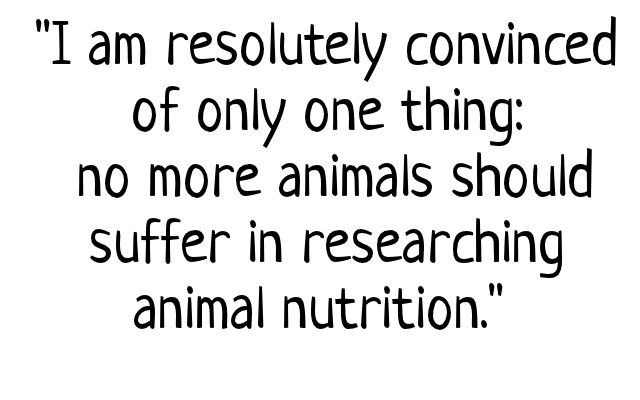 Another important aspect of “obligate carnivore” is the well cited Taurine issue: humans and dogs, for example, can use Taurine OR glycine to make bile salts (which are later used to emulsify fats). Cats, however, can only use Taurine for this, and because they synthesize Taurine in the liver “at a relatively low rate”, it is important that they attain Taurine from their food. Because Taurine “occurs at low levels in non-animal tissue”, cat food made using only plant ingredients must be supplemented with artificial Taurine. However, meat pet food is very definitely supplemented with artificial Taurine too [12], presumably because meat foods are also often plant based anyway and because Taurine is lost during meat processing [13]. It’s important that the nutritional needs of your cat are met, no matter what kind of food you buy.
Another important aspect of “obligate carnivore” is the well cited Taurine issue: humans and dogs, for example, can use Taurine OR glycine to make bile salts (which are later used to emulsify fats). Cats, however, can only use Taurine for this, and because they synthesize Taurine in the liver “at a relatively low rate”, it is important that they attain Taurine from their food. Because Taurine “occurs at low levels in non-animal tissue”, cat food made using only plant ingredients must be supplemented with artificial Taurine. However, meat pet food is very definitely supplemented with artificial Taurine too [12], presumably because meat foods are also often plant based anyway and because Taurine is lost during meat processing [13]. It’s important that the nutritional needs of your cat are met, no matter what kind of food you buy.
It’s all so complicated!
I know! Scientists will be sporadically discussing the relevance of “obligate carnivore” to vegan domestic cats for a long time to come, however, even those who are opposed to vegan cat food cannot find a concrete scientific basis for dismissing vegan cat food entirely. In Gray’s (frankly rather antagonistically written) paper, the most definitive statement made is “When animal tissue is eliminated from the diet of an obligate carnivore, the potential for nutritional deficiencies increases. Various nutrients essential to cats are of potential concern in a vegan diet due to their scarcity in plant material.” [14] Potential. Potential! We should be careful, but not afraid.
So what is the conclusion?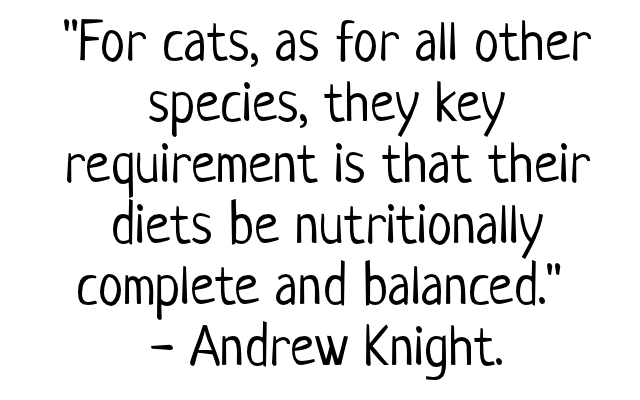
Personally, I am resolutely convinced of only one thing: no more animals should suffer for research in animal nutrition. We all love our pets, and want to give them the perfect diet, but brutalizing other animals in search of the best recipe is just not on. As for the rest? We should all calm down a little bit really – if you feel that the moral and health issues surrounding meat warrant a trial of vegan foods, have a go, take it slowly and see how your cat responds. If your cat is happy on a vegan diet then you will be saving the lives of many other animals and reducing your carbon footprint in the process – I would suggest that it is worth a try… but that is only my opinion. What is yours?
References
[1] Nutritional adequacy of two vegan diets for cats, by Christina M. Gray, DVM Rance K. Sellon, DVM, PhD, DACVIM Lisa M. Freeman, DVM, PhD, DACVN from The Journal of the American Veterinary Medical Association, 2004, Vol. 225, No. 11, Pages 1670-1675. I have only read an unpublished version of this paper; there is a good summary here.
[1b] As above and also, see [11]
[2] (2006) Evaluation of cats fed vegetarian diets and attitudes of their caregivers, by Lorelei A. Wakefield, Frances S. Shofer, Kathryn E. Michel from The Journal of the American Veterinary Medical Association, 2006. 229:1, 70-73 Freely available to download here.
[3] The Gray paper states that “kittens fed a taurine-deficient diet exhibit poor growth” – referenced as 7. I searched for this reference (“National Research Council. Nutrient requirements of cats. Washington, DC: National Academy Press, 1986.”) and then searched within the book for references to Taurine and kittens. This was the first study which I read about; the kittens were killed before they had even taken milk.
[4] The Benevo levels were sent to me by email on request, the Yarrah levels are available here. Due to the low level of Taurine described, I rang them to ask some questions; the levels described are what are added into the food, so there will be more occurring naturally in the meat. AFFCO, diet A and diet B levels are from the Gray 2003 paper, FEDIAF are available here and Purina told me the ProPlan levels when I called them on their hot-line, but would not disclose the go cat levels. Yarah were very help full, but I found both Benevo and Purina to be stubborn about disclosing some of the information. I suspect there is some kind of “common knowledge” in pet food manufacture that a) levels will fluctuate from batch to batch and vary depending on storage and b) most foods are supplemented with similar/identical premix. That is my deduction anyway. Also, please note that I removed two very large levels from diet a/b to make the graph easier to read. The graph isn’t really very valid scientifically, please look at the original data for the best information.
[5] Article from Lifesapemag.com, May 2008: available to download here. Well worth a read.
[6] https://www.crpf.org.uk/index.php?section=538
[7] I looked at the linking sites from the page about certified brands.
[8] Article from Lifesapemag.com, marked page 74, third column): available to download here.
[9] https://www.vegepets.info/pages/meat_based_commercial_diets.htm
[10] I found the original article by the FDA here, which is where I got the quote.
[11] From Knight, A. In defense of vegetarian cat food. J. Amer. Vet. Medical. Assoc. 2005, 15 Feb.; Vol. 226 No. 4 pp. 512-513. – available here.
[12] I have head this but not seen it referenced. However, According to a well researched wikipedia article “In 1993, approximately 5/6000 tons of taurine were produced for commercial purposes; 50% [of which is] for pet food manufacture” – the AAFCO required level stated in the Gray study is only 0.1% of each meal… that’s 0.05g of a 50g serving… so sixty thousand million (or 60 Billion in USA speak) 50g pet meals are supplemented a year. That’s certainly not just the vegan foods!! Yarrah have explained that their foods have a supplement added, but I bet you would find it hard to get most companies to even admit this: this really just continues the myth that cats get everything they need from meat based foods.
[13] This is again only from my own understanding and from the non-referenced sources I have read.
[14] From page five of ref [1]
s
